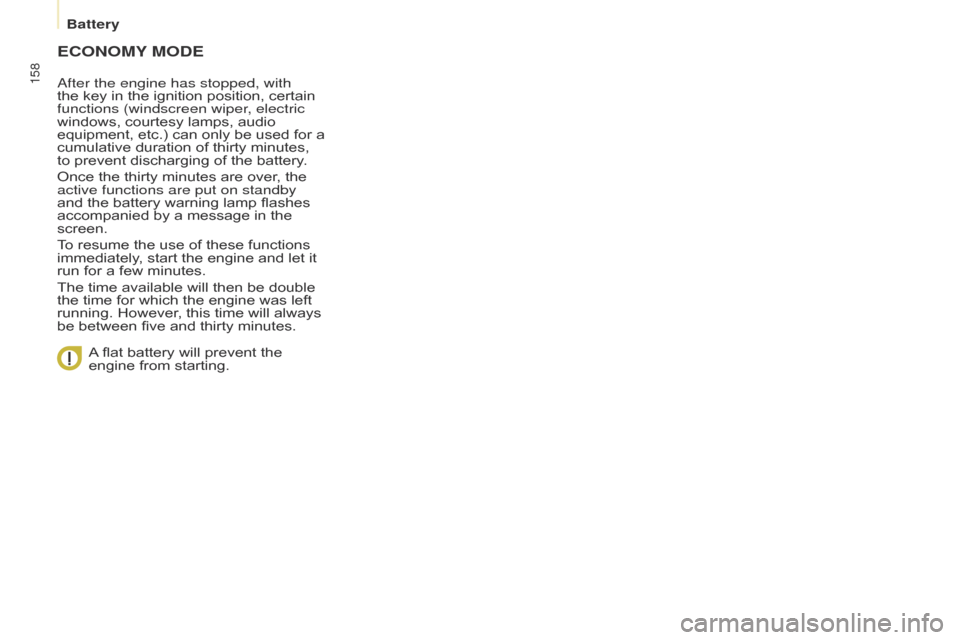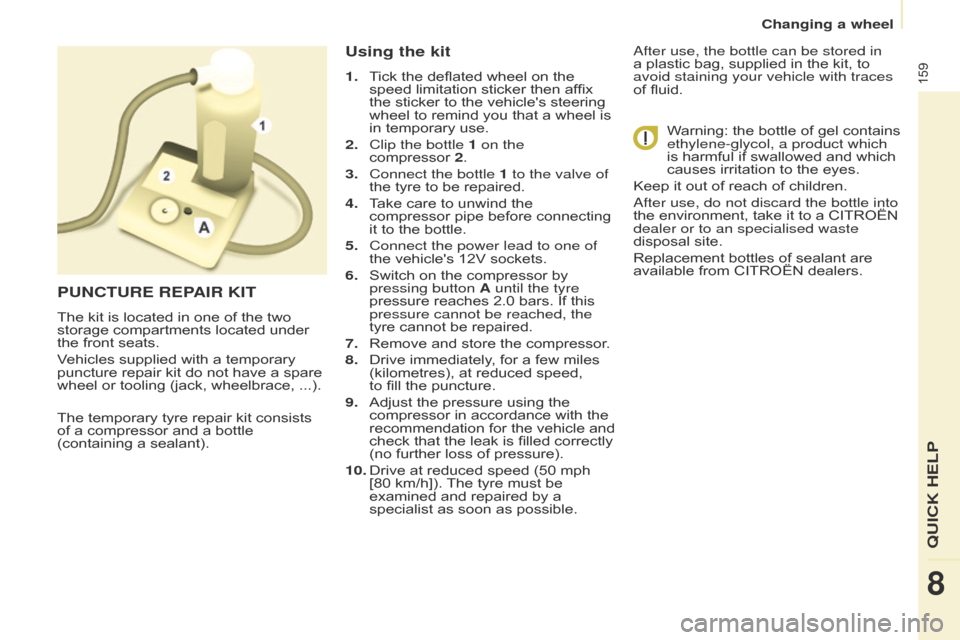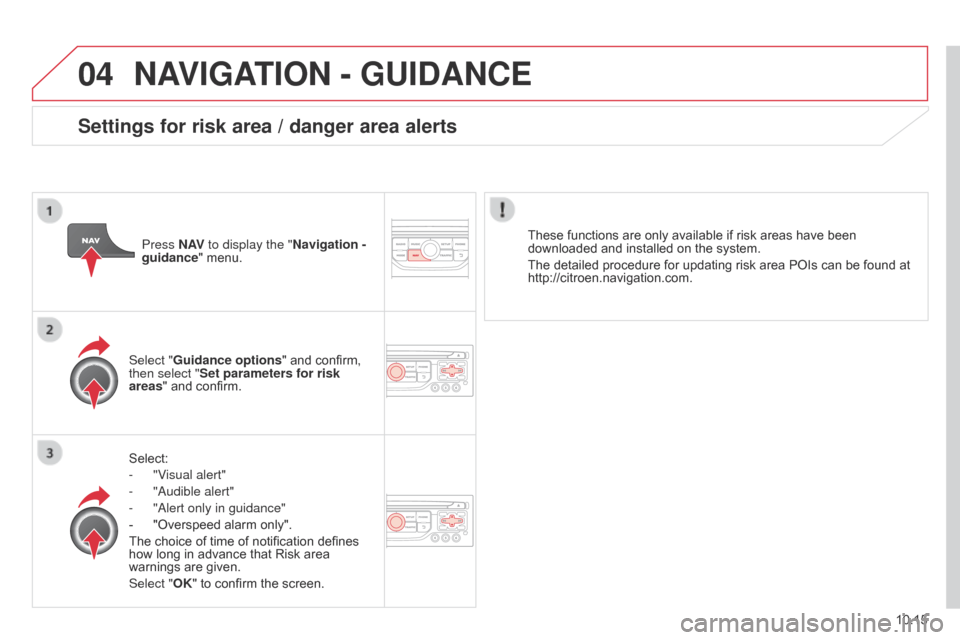warning Citroen BERLINGO MULTISPACE RHD 2015 2.G Workshop Manual
[x] Cancel search | Manufacturer: CITROEN, Model Year: 2015, Model line: BERLINGO MULTISPACE RHD, Model: Citroen BERLINGO MULTISPACE RHD 2015 2.GPages: 276, PDF Size: 12.21 MB
Page 155 of 276

Berlingo_2_VP_en_Chap07_Verification_ed02-2014
153
Every time the ignition is switched on, the SERVICE and engine diagnostic
warning
lamps come on and the UREA
warning
lamp flashes, accompanied
by an audible signal and the display of
the
message "Emissions fault: Starting
prevented".
Y
ou have exceeded the authorised
driving
limit: the starting
prevention
system inhibits engine
starting.
T
o be able to start the engine, you
must
call on a CITROËN dealer or a
qualified
workshop.
Starting prevented
The a dBlue
® additive freezes at
temperatures below around -11°C.
The
SCR
system includes a heater for
the
a
dBlue
® tank.
In
exceptional circumstances (vehicle
kept
for
a
long period at temperatures
that
are
constantly below -15°C), an
emissions
control system fault alert
may
be
related to freezing of the
a
dBlue
® in your vehicle.
Park
your vehicle in a warmer area for
a
few
hours until the additive becomes
liquid
again.
The
emissions alert does not go off
immediately
, it will occur after several
mile
of
running.
Freezing of the AdBlue
® additive
adBlue® additive
CHECkS
7
Page 156 of 276

Berlingo_2_VP_en_Chap07_Verification_ed02-2014
154
topping-up the AdBlue® additive
Filling the adBlue® tank is an operation included in every routine service on
your vehicle by a CITR
o Ë n dealer
or
a
qualified
workshop.
n
evertheless, given the capacity
of
the
tank,
it
may
be necessary to
top-up the additive between services,
more
particularly
if an alert (warning
lamps
and
a
message) signals the
requirement.
Y
ou can got to a CITR o Ë n dealer
or
a
qualified
workshop.
If you envisage topping-up yourself,
please read the following warnings
carefully. Precautions in use
The
a dBlue® additive is an urea-based
solution.
This liquid is non-flammable,
colourless
and odourless (kept in a
cool
area).
In
the
event
of contact with the skin,
wash the af
fected area with soap and
water.
In
the
event of contact with the
eyes, wash (irrigate) the eyes with
large
amounts of water or with an eye
wash
solution for at least 15 minutes.
If a burning sensation or irritation
persists,
get
medical attention.
If
swallowed, immediately wash out the
mouth
with
clean water and then drink
plenty
of
water.
In
certain
conditions (high ambient
temperature,
for example), the risk
of
release
of
ammonia cannot be
excluded:
do not inhale the product.
Ammonia
vapour has en irritant effect
on
mucous
membranes (eyes, nose
and
throat).
k
eep
a
dBlue
® out of the reach of
children,
in
its
original bottle.
n
ever transfer
a
dBlue
® to another
container:
it
would
loose its purity. Use only
a dBlue
® additive that meets the
ISO
22241
standard.
n
ever dilute the additive with
water.
n
ever pour the additive into the d iesel
fuel
tank.
The supply in a non-drip bottle
simplifies
toping-up.
Y
ou can obtain
1.89
litre
(half
a
US gallon) bottles
from
a
CITROËN dealer or a qualified
workshop.Never
top-up from an
AdBlue®
dispenser reserved for heavy
goods
vehicles.
adBlue® additive
Page 160 of 276

158
Berlingo_2_VP_en_Chap08_aide-rapide_ed02-2014
EcOnOMY MOdE
after the engine has stopped, with
the key in the ignition position, certain
functions (windscreen wiper
, electric
windows,
courtesy lamps, audio
equipment,
etc.) can only be used for a
cumulative
duration of thirty minutes,
to
prevent discharging of the battery.
Once
the thirty minutes are over, the
active functions are put on standby
and
the battery warning lamp flashes
accompanied
by a message in the
screen.
T
o resume the use of these functions
immediately
, start the engine and let it
run
for a few minutes.
The
time available will then be double
the
time for which the engine was left
running.
However, this time will always
be
between five and thirty minutes.
A
flat battery will prevent the
engine
from starting.
Battery
Page 161 of 276

Berlingo_2_VP_en_Chap08_aide-rapide_ed02-2014
159
The temporary tyre repair kit consists of a compressor and a bottle
(containing
a sealant).
using the kit
1. Tick the deflated wheel on the speed
limitation sticker then affix
the
sticker to the vehicle's steering
wheel
to remind you that a wheel is
in
temporary use.
2.
Clip the bottle
1 on the
compressor 2.
3.
Connect the bottle
1 to the valve of
the
tyre to be repaired.
4.
T
ake care to unwind the
compressor
pipe before connecting
it
to the bottle.
5.
Connect the power lead to one of
the
vehicle's 12V sockets.
6.
Switch
on the compressor by
pressing button
A until the tyre
pressure
reaches 2.0 bars. If this
pressure cannot be reached, the
tyre
cannot be repaired.
7.
Remove
and store the compressor.
8.
Drive
immediately, for a few miles
(kilometres),
at reduced speed,
to
fill the puncture.
9.
Adjust
the pressure using the
compressor
in accordance with the
recommendation
for
the
vehicle
and
check
that the leak is filled correctly
(no
further loss of pressure).
10.
Drive
at reduced speed (50 mph
[80
km/h]).
The
tyre must be
examined
and repaired by a
specialist
as soon as possible.
a
fter use, the bottle can be stored in
a plastic bag, supplied in the kit, to avoid staining your vehicle with traces
of
fluid.
Warning:
the bottle of gel contains
ethylene-glycol, a product which
is
harmful if swallowed and which
causes
irritation to the eyes.
Keep
it out of reach of children.
a
fter use, do not discard the bottle into
the
environment, take it to a CITROËN
dealer or to an specialised waste
disposal
site.
Replacement
bottles of sealant are
available
from CITROËN dealers.
PuncturE rEPAIr KIt
The kit is located in one of the two storage compartments located under
the
front seats.
Vehicles
supplied with a temporary
puncture
repair kit do not have a spare
wheel
or tooling (jack, wheelbrace, ...).
Changing a wheel
QUICk HELP
8
Page 205 of 276

04
10.15
Berlingo_2_VP_en_Chap10b_RT6-2-8_ed02-2014
nAVIGAtIO n - Gu I d A nc E
Select:
-
"V
isual alert"
-
"
a udible alert"
-
"
a lert only in guidance"
-
"Overspeed
alarm only".
The
choice of time of notification defines
how
long in advance that Risk area
warnings
are given.
Select "OK"
to confirm the screen.
Select "Guidance options
" and confirm,
then select "
Set parameters for risk
areas " and confirm. These functions are only available if risk areas have been
downloaded
and installed on the system.
The detailed procedure for updating risk area POIs can be found at
http://citroen.navigation.com.
Press
n
AV
to display the "
n avigation -
guidance" menu.
Settings for risk area / danger area alerts
Page 242 of 276

10.52
Berlingo_2_VP_en_Chap10b_RT6-2-8_ed02-2014
The following table groups together the answers to the most frequently asked questions concerning your audio system.
FrEQuEntLY ASKE d Q u ES t IO n S
QuEStIOnA n SWE rSOL ut IO n
The route calculation is
not
successful. The
guidance criteria may conflict with the current location (exclusion of
toll
roads on a toll motorway). Check
the guidance criteria on the Navigation
Menu,
"Guidance options"\ "Define calculation
criteria".
I
am
unable to enter my
post
code. The
system only accepts post codes of up to 7 characters.
The
POIs do not appear. The POIs have not been selected. Select
the POIs in the list of POIs.
The
risk areas audible
warning
does not work.The
audible warning is not active.
a
ctivate audible warnings in the Guidance options
menu,
"Navigation - guidance", "Set parameters
for
risk areas".
The
system does not
suggest a detour around
an
incident on the route.The
guidance criteria do not take account of
TMC
messages.Select
the "Traffic info" function in the list of
guidance
criteria.
I
receive a Risk area alert
which
is not on my route.Other
than guidance, the system announces all Risk areas positioned in a
cone
located in front of the vehicle. It may provide an alert for a Risk area
located
on nearby or parallel roads.Zoom
in on the map to view the exact position of
the
Risk area. Select "On the route" to no longer
receive alerts other than guidance or to reduce the
time
for the announcement.